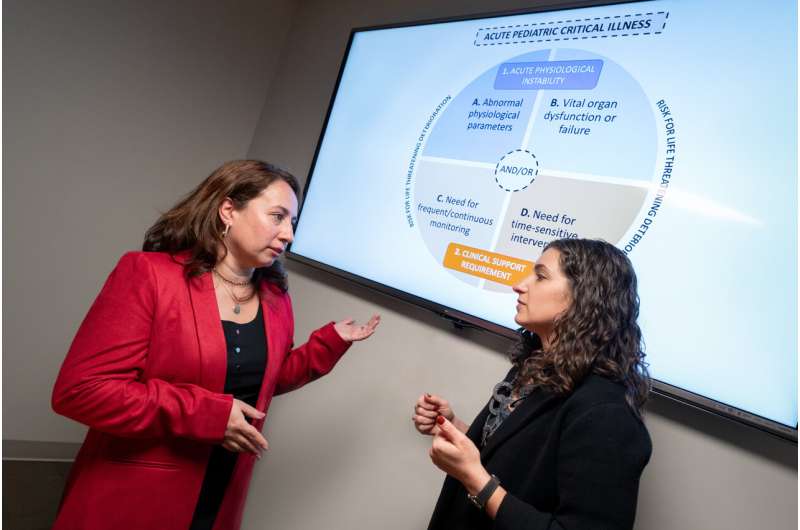This article has been reviewed according to Science X's editorial process and policies. Editors have highlighted the following attributes while ensuring the content's credibility:
fact-checked
peer-reviewed publication
trusted source
proofread
Researchers reach consensus on definition of acute pediatric critical illness

St. Jude Children's Research Hospital investigators have collaborated with a global group of acute pediatric critical illness experts to reach a consensus definition of the condition. Research on how to improve care in low- and middle-income countries has been stymied because conventional pediatric critical illness definitions are not applicable in these settings.
The new, more universal definition, reached by consensus among researchers and clinicians from 40 countries, will enable scientists to study pediatric critical illness more universally, which should lead to improvements in patient outcomes globally. The full definition is published in The Lancet Global Health.
"We now have a common language for acute pediatric critical illness," said first and corresponding author Anita Arias, M.D., St. Jude Department of Pediatric Medicine. "That shared understanding will improve data collection globally and increase patient sample size, which will lead to more and better clinical studies of evidence-based interventions."
The new full definition is: "An infant, child or adolescent with an illness, injury or post-operative state that increases the risk for or results in acute physiological instability (abnormal physiological parameters or vital organ dysfunction or failure) or a clinical support requirement (such as frequent or continuous monitoring, or time-sensitive intervention) to prevent further deterioration or death. The patient can meet this definition by having physiological instability, support requirements or both."
St. Jude researchers, led by Arias and senior author Asya Agulnik, M.D., MPH, St. Jude Global Critical Care director, coordinated an international group of acute pediatric critical illness researchers and clinicians to assemble the definition. In total, 109 experts from 40 countries contributed. The participants used a method called modified Delphi, which anonymized those involved so they could freely vote and express their opinions on draft statements. The final definition was a consensus among these experts, with particular attention to being more inclusive of hospitals of differing resource levels.
A more inclusive patient-centered definition
Historically, acute pediatric critical illness has had many definitions. Studies from higher-income countries tend to use definitions that include technical or resource-based terminology, such as admission to an Intensive Care Unit (ICU). While that criterion has proven clinically useful, it does not translate to resource-limited health care settings in other countries, which may not have an ICU in their hospitals.
"With our new framework, we're trying to be more inclusive," Arias said. "As many hospitals around the world don't even have an ICU, older definitions were excluding a huge population of patients from research."
"While the global burden of childhood mortality is mostly in low-and middle-income countries, to date, the study of acute pediatric critical illness has largely been centered on hospitals in high-resource settings," Agulnik said. "This definition, which allows for classification of patients as critically ill regardless of critical care resources, would address this research disparity by facilitating research in hospitals of all resource settings."
The focus on ICUs reveals a larger problem: previous definitions excluded patients experiencing acute critical illness but lacking access to critical care resources. To increase inclusivity, the international group recognized the need to define the condition based on the patient's status rather than on resources, such as specific department admission or intervention use.
"One example of why we needed a new definition is the studies of respiratory failure," Arias explained. "Traditionally, these studies include patients who are on mechanical ventilation, but the fact that a hospital might not have mechanical ventilation doesn't mean that the patient doesn't have acute respiratory illness or failure."
The new definition focuses on the patient to address that need without regard to local resources. It looks at two different states—what is happening with the patient's bodily systems, and the need for clinical support, such as needing a ventilator, but not the actual materials used to address the patient's needs.
The framework also provides eight attributes and 28 statements to clarify and explain its application. The entirety of that framework is termed the DEFinition for acute pediatric CRITical illness (DEFCRIT).
Improving care globally
Slow improvement in critical care can be attributed to the historical lack of a standardized and inclusive definition of acute pediatric critical illness, particularly in low- and middle-income countries. Given the difficulty in adapting methods to these settings, even measuring the total burden of critical illness has evaded researchers. DEFCRIT will help lead to a better understanding of the burden of disease and begin to compare populations and interventions in a more standardized and inclusive way.
"We have started bridging a gap for researchers and clinicians to understand the global burden of critical illness," Arias said. "This could eventually lead to better care delivery by gaining the ability to determine how effective intervention can be in different populations, environments and stages of illness."
Multiple global groups of pediatric disease researchers have already accepted DEFCRIT. The Pediatric Acute Lung Injury and Sepsis Investigators (PALISI) Network on Behalf of the PALISI Global Health Subgroup is a co-author of the paper. In addition, the World Federation of Pediatric Intensive and Critical Care Societies (WFPICCS) and the Society of Critical Care Medicine (SCCM) have both endorsed the framework.
"There was an iniquity in research that we, as a global group, wanted to address," Arias said. "With a universal DEFCRIT, we've stopped impeding research progress. We're now going to be able to start pushing the field toward improving the care for patients globally through better research."
More information: Anita V Arias et al, A research definition and framework for acute paediatric critical illness across resource-variable settings: a modified Delphi consensus, The Lancet Global Health (2024). DOI: 10.1016/S2214-109X(23)00537-5


















